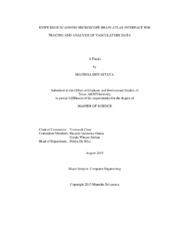| dc.description.abstract | The study of the neurovascular network in the brain is important to understand brain functions as well as causes of several brain dysfunctions. Many techniques have been applied to acquire neurovascular data. The Knife-Edge Scanning Microscope (KESM), developed by the Brain Network Lab at Texas A&M University, can generate whole-brain-scale data at submicrometer resolution. The specimen can be stained with different stains, and depending on the type of stain used, the KESM can image different types of microstructures in the brain. The India ink stain allows the neurovascular network in the brain to be imaged.
In order to visualize and analyze such large datasets (~ 1.5 TB per brain), a lightweight, web-based mouse brain atlas called the Knife-Edge Scanning Microscope Brain Atlas (KESMBA) was developed in the lab. The atlas serves several whole mouse brain data sets including India ink. The multi-section overlay technique used in the atlas enables 3D visualization of the structural information in the data. To solve the challenging issue of tracing micro-vessels in the brain, in this thesis a semi-automated tracing and analysis method is developed and integrated into the KESM brain atlas.
Using the KESMBA interface developed in this thesis, the user can look at the 3D structure of the vessels on the brain atlas and can guide the tracing algorithm. To analyze the vasculature network traced by the user, a data analysis component is also added. This new KESMBA interface is expected to help in quickly tracing and analyzing the vascular network of the brain with minimal manual effort.
In order to visualize and analyze such large data sets (~ 1.5 TB per brain), a light-weight, web-based mouse brain atlas called the Knife-Edge Scanning Microscope Brain Atlas (KESMBA) was developed in the lab. The atlas serves several whole mouse brain data sets including India ink. The multi-section overlay technique used in the atlas enables 3D visualization of the structural information in the data. To solve the challenging issue of tracing micro-vessels in the brain, in this thesis a semi-automated tracing and analysis method is developed and integrated into the KESM brain atlas.
Using the KESMBA interface developed in this thesis, the user can look at the 3D structure of the vessels on the brain atlas and can guide the tracing algorithm. In order to analyze the vasculature network traced by the user, a data analysis component is also added. This new KESMBA interface is expected to help in quickly tracing and analyzing the vascular network of the brain with minimal manual effort. | en |


